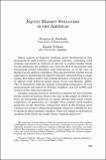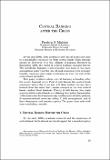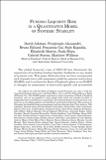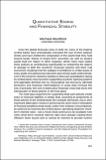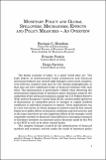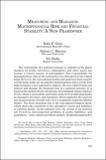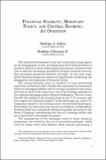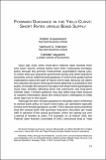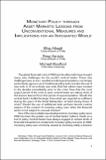Search
Now showing items 1-10 of 23
Equity market spillovers in the Americas
Many aspects of financial markets merit monitoring in risk management and portfolio allocation contexts, including (and perhaps especially) in contexts of interest to central banks. Much recent attention, for example, has been devoted to measuring and forecasting return volatilities and correlations, ...
Central banking after the crisis
By the mid-2000s both academics and central banks had come to a remarkable consensus on what central banks’ basic strategy should be. However with the collapse of Lehman Brothers in September 2008 the world of central banking changed forever. The worldwide financial crisis revealed that some of the ...
Funding liquidity risk in a quantitative model of systemic stability
The global financial crisis of 2007–09 has illustrated the importance of including funding liquidity feedbacks in any model of systemic risk. This paper illustrates how we have incorporated such channels into a risk assessment model for systemic institutions (RAMSI) and it outlines the Bank of England’s ...
Monetary policy under financial turbulence: an overview
The financial crisis that started in 2007 brought the global economy to the brink and in many respects it is still unfolding especially in Europe. How to understand and deal with the crisis has naturally been the subject of fierce debates that continue today. However some consensus appears to be ...
Quantitative easing and financial stability
Since the global financial crisis of 2008–09 many of the leading central banks have dramatically increased the size of their balance sheets and have shifted the composition of the assets that they hold toward larger shares of longer-term securities (as well as toward assets that are riskier in other ...
Monetary policy and global spillovers: mechanisms effects and policy measures: an overview
The global economy of today 'is a small world after all.' The high degree of international trade integration and financial interconnectedness has created tight linkages across most countries even between countries that may be very distant geographically or that may not have significant trade or financial ...
Measuring and managing macrofinancial risk and financial stability: a new framework
The vulnerability of a national economy to volatility in the global markets for credit, currencies, commodities, and other assets has become a central concern of policymakers. The responsibility for managing these risks at the national level is often given to the central bank. However, the conventional ...
Financial stability monetary policy and Central Banking: an overview
The financial developments of the last decade had a large impact on the management of risk providing more diversified portfolios to investors. Based on these complex financial contracts investors were able to shift the investment possibilities frontier outward however that movement generated intricate ...
Forward guidance in hte yield curve: short rates versis bond supply
Since late 2008 when short-term interest rates reached their zero lower bound central banks have been conducting monetary policy through two primary instruments: quantitative easing (QE) in which they buy long-term government bonds and other long-term securities and so-called forward guidance in which ...
Monetary policy thorugh asset markets: lessons from unconventional measures and implications for an integrated world
The global financial crisis of 2008 and its aftermath have brought many new challenges for the world’s central banks. These new challenges have in turn resulted in bold experimentation—not simply particularly vigorous use of traditional policy tools but also the use of new tools or if not entirely new ...

